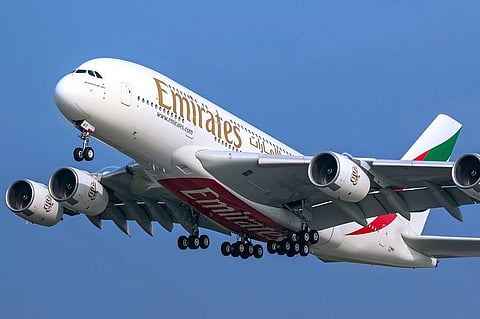Emirates to reduce unexpected severe turbulence incidents with new crucial steps
Emirates uses AI, real-time data to predict turbulence, improving flight safety, it said

Dubai: Emirates revealed how it is reducing unexpected severe turbulence encounters across its network by introducing new AI-driven weather forecasting and real-time turbulence detection systems.
The airline said on Wednesday the initiative has improved flight comfort and safety for passengers and crew.
Turbulence incidents have increased globally due to changing weather patterns. In response, Emirates implemented a multi-layered data strategy that combines information from several advanced platforms to predict and avoid turbulent zones more accurately.
AI, data partnerships
The airline’s current setup integrates three complementary systems — SkyPath, Lido mPilot from Lufthansa Systems, and IATA’s Turbulence Aware platform. Together, they provide live weather insights, data sharing between airlines, and predictive analytics.
SkyPath uses AI and machine learning to analyse turbulence data gathered from aircraft sensors, transponders, and even iPad accelerometers to detect “clear air” turbulence invisible to radar.
Lido mPilot, developed with Lufthansa Systems, supplies Emirates with real-time global weather data, including cloud formations and turbulence predictions, improving pilots’ situational awareness.
IATA Turbulence Aware aggregates live reports from global airlines, allowing Emirates pilots to access real-time turbulence maps directly through their electronic flight bag.
Better comfort, safety
Captain Hassan Alhammadi, Divisional Senior Vice President of Flight Operations at Emirates, said the programme reflects the airline’s long-term investment in technology to improve safety and efficiency.
“We recognise that turbulence cannot be completely eliminated, but we are doing everything possible to minimise unexpected encounters through partnerships and advanced technologies,” he said.
He added that the airline’s initiatives have already led to “a significant reduction in unexpected severe turbulence incidents” over the past year.
Industry-wide innovation
By sharing its turbulence data through IATA’s global platform, Emirates is also supporting wider industry efforts to develop more accurate forecasting systems.
The airline’s approach combines real-time data from multiple sources, artificial intelligence, and pilot feedback to enhance both passenger experience and operational efficiency.
Emirates’ proactive adoption of AI and predictive technologies underscores its ongoing commitment to flight safety and innovation across its global network.
Sign up for the Daily Briefing
Get the latest news and updates straight to your inbox


